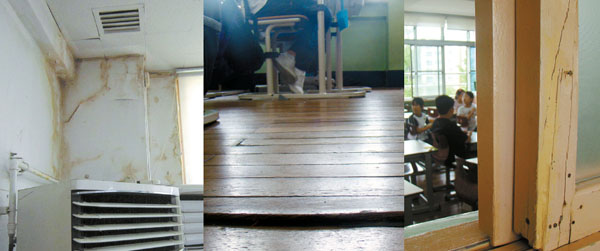Ceilings leak while students eat free

Water leaks from the classroom ceiling at an elementary school in northern Seoul (left). Another elementary school in Yangcheon District, western Seoul, has not replaced its cracked wooden floors and window frames for 28 years. By Lee Han-gil, Kim Kyung-hee
When long-awaited rain fell across the country over the weekend, workers at one elementary school in northern Seoul were increasingly concerned for their school building.
“I am not sure if the building will make it through the monsoon season this year,” said a school manager.
Many parts of the 29-year-old school were leaking.
Sudden leaks from classroom ceilings and pillars forced teachers to use buckets to collect the water. Still, class carried on with the sound of water dripping into the buckets.
Another elementary school in Yangcheon District, western Seoul, is experiencing other issues related to having an outdated facility.
The cracked, wooden floors creak with every step a student takes.
“When I try to pick up a piece of garbage from the floor, I get splinters,” a fourth-grader surnamed Park told the JoongAng Ilbo.
The Seoul Metropolitan Office of Education mandates that schools renovate their wooden floors and classroom windows every 15 and 25 years, respectively. Park’s school, however, has not changed its classroom windows since it was built in 1984.
“I’ve appealed to the Seoul education office every year for repair funding, but was told every time that the budget is too tight,” said the school principal.
For students, a classroom is more than just a place to be taught. Elementary students spend four to seven hours in the classroom every day, while middle and high school students stay there up to 12 hours a day, spending more time in the classroom than at home.
Conditions at school facilities, however, fall far short of proper management. While the government boasts Korea has entered the phase of “digital education,” 516 schools, or 23.6 percent, of a total of 2,184 schools in Gyeonggi have problems with leaks.
Despite worsening conditions at schools, the Ministry of Education, Science and Technology and regional education offices do not appear to fully grasp the extent of the problems.
The Gangwon education office is the only provincial education office among the 16 offices in the country that looked into their schools’ conditions.
Among its 18,993 schools, the education authority found in 2007 that 2,164 schools required replacements of their wooden floors, while 2,325 schools needed window replacements.
More than one in 10 schools in the province needed waterproofing.
“More funding of remodeling outdated school facilities is needed to ensure students study in an appropriate environment that could improve learning performance,” said Yu Ho-seob, professor of architecture at Dong-eui University in Busan.
Some teachers attribute the lack of funding for repairs to the free school-lunch campaign.
“After looking into the Seoul education office’s budget for the past two years, we discovered funds for free school lunches increased by seven-fold while budgets for school facilities were cut in half,” said the Korea Federation of Teachers’ Association, on Sunday.
Backing up its claim, the Seoul education office’s free lunch budget climbed to 138.1 billion won ($120.8 million) from 17.2 billion won, while facility budgets plunged to 284.9 billion won from 617.9 billion won.
By Special Reporting Team [jkkang2@joongang.co.kr]










with the Korea JoongAng Daily
To write comments, please log in to one of the accounts.
Standards Board Policy (0/250자)